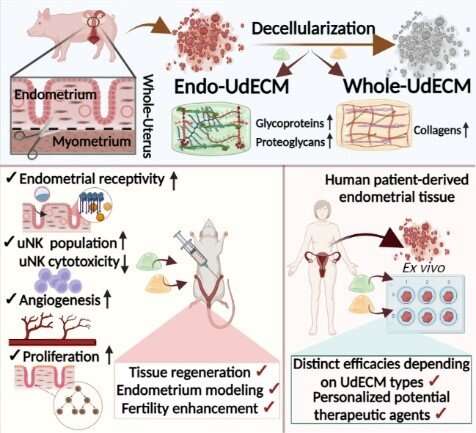This article has been reviewed according to Science X's editorial process and policies. Editors have highlighted the following attributes while ensuring the content's credibility:
fact-checked
peer-reviewed publication
trusted source
proofread
A novel hydrogel may be a beacon of hope for infertility and fertility challenges

The Health Insurance Review & Assessment Service revealed that over the last year, more than 370,000 Koreans sought medical help for infertility or difficulties in conceiving. This represents a 4.7% increase in infertility-related treatments and a 16% rise in subfertility-related treatments compared to the 2018 data.
Korea's birth rate may be declining, but an increasing number of people are seeking medical attention for these issues. These conditions may stem from numerous factors, so an accurate determination of the cause is crucial. Both the individual's gender and the nature of the problem must be taken into account before deciding on the appropriate treatment.
A healthy endometrium plays a pivotal role in successful pregnancies. A thin endometrium reduces the likelihood of effective embryo implantation, with a high chance of subsequent miscarriage—a significant contributing factor to female infertility. Current treatment approaches, such as hormone therapy and endometrial injections, have shown limited success.
A joint research team from Pohang University of Science and Technology (POSTECH, President Moo Hwan Kim) and CHA University, took one step closer to personalized treatment by developing a gel that mimics the environment of uterine cells, inducing endometrial regeneration and elucidating its mechanism.
The team, led by Professor Dong-Woo Cho from Department of Mechanical Engineering, Professor Jinah Jang from the Department of Mechanical Engineering and the Department of Convergence IT Engineering, Ph.D. student Tugce Sen from the Department of Mechanical Engineering at POSTECH in collaboration with Professor Youn-Jung Kang and Dr. Jungho Ahn from the Department of Biochemistry at the School of Medicine and Ph.D. student Danbi Lee from the Department of Biomedical Science at the School of Life Science, CHA University, developed a hydrogel using a uterus-derived decellularized extracellular matrix (UdECM).
Their study demonstrated that this hydrogel could regenerate the endometrium, and for the first time, revealed the mechanism controlling this process. The research has been published in Advanced Functional Materials.
Decellularized extracellular matrices (dECMs) are assemblies of biomolecules with cellular components, such as the nucleus and cell membranes, removed. These matrices closely resemble the in vivo environment, so they are used in regeneration and transplantation of tissue and organs such as the heart and kidneys. They are also employed in tissue fabrication through 3D printing.
The team developed a hydrogel based on UdECMs, with characteristics from two different tissues: the entire uterine tissue and a specific layer of the endometrium. The protein composition of the hydrogel closely resembled the actual endometrial components and was tested in animal models to verify its effectiveness. When injected, the hydrogel was found to induce the recovery of the endometrial thickness in mice, creating a favorable environment for embryo implantation. As a biomaterial, the hydrogel has low cytotoxicity, ensuring a 90% survival rate of implanted embryos.
The research team further discovered the involvement of insulin-like growth factor (IGF1) and insulin growth factor-binding protein (IGFBP3) in endometrial regeneration. This discovery provides a platform for research on endometrial regeneration going forward. In addition, depending on the tissue from which the hydrogel is made, such as the endometrium and muscles, the team confirmed therapeutic effects against various conditions such as intrauterine adhesions and repeated implantation failures. This opens the way for personalized treatments based on the state of the patient's endometrium.
Professor Dong-Woo Cho, who led the research, is optimistic about their research potential, stating "We have successfully developed a uterine tissue-specific hydrogel for endometrial regeneration and successful pregnancy. I am hopeful that further research into its clinical application can bring hope to patients grappling with infertility."
More information: Jungho Ahn et al, Uterus‐Derived Decellularized Extracellular Matrix‐Mediated Endometrial Regeneration and Fertility Enhancement, Advanced Functional Materials (2023). DOI: 10.1002/adfm.202214291



















